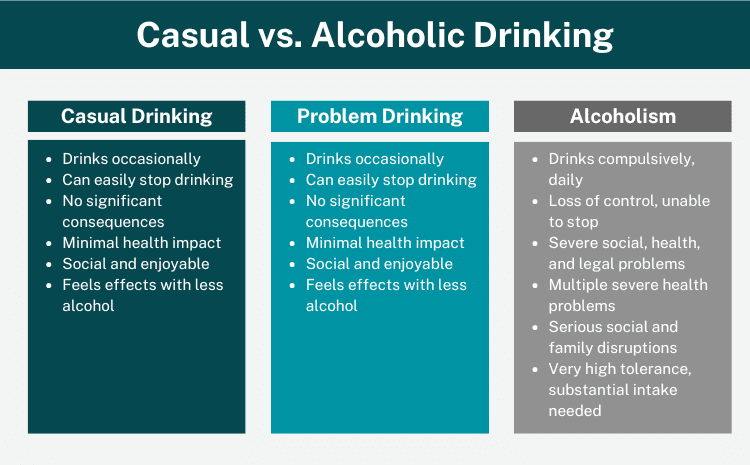Casual Drinking Vs Alcoholism
Drinking alcohol is a familiar activity in many social settings, from festive celebrations to casual meet-ups. For most people, it’s a way to relax and enjoy time with friends and family. In the United States, having a drink or two at social events is commonly accepted and often expected.
However, the effects of alcohol on individuals can vary greatly. It’s not just about knowing when casual drinking turns into something more concerning. It’s also about understanding how alcohol affects our health, relationships, and daily lives. This understanding is crucial because it helps us appreciate why moderation matters and recognize the signs when drinking becomes harmful.
In this article, we’ll explore the social acceptance of alcohol and its role in our lives, and we’ll look at how something that is often seen as harmless can sometimes lead to significant problems. By examining these topics, we aim to provide insights into both the pleasures and potential dangers of drinking. This balanced view can help anyone make more informed decisions about their own alcohol consumption.

Casual Vs. Alcoholic Drinking
If you’re concerned about someone’s drinking habits, understanding the key differences between casual and alcoholic drinking is crucial.
What is Casual Drinking
Casual drinking, also known as social drinking, involves consuming alcohol in low doses and typically only on occasion. For many, it’s about the social experience rather than the need to consume alcohol. Social drinkers often enjoy a glass of wine or a beer during special events or gatherings, seeing it as a way to enhance the moment with friends or family.
This pattern of drinking emphasizes control and moderation. Casual drinkers rarely experience negative consequences such as getting drunk or blacking out because they drink responsibly. They choose when and where to drink, ensuring that it does not disrupt their daily responsibilities, whether at work or home.
The Centers for Disease Control and Prevention (CDC) defines moderate drinking as up to one drink per day for women and up to two drinks per day for men. This guideline closely aligns with the behavior of most casual drinkers, highlighting their ability to maintain a balance between enjoying a drink and managing their health and social obligations.
What Does Responsible Casual Drinking Look Like?
Responsible drinking involves making choices that ensure your safety and the safety of others. It means drinking slowly to avoid getting drunk and choosing the right environment, such as being around trusted friends. Responsible drinkers often follow certain practices like eating before drinking, alternating alcoholic drinks with water, avoiding high-alcohol content beverages, and staying clear of drinking games. They also make sure a sober driver is available and drink only in suitable settings.
Characteristics of Casual Drinking
Here are some typical characteristics that define a casual drinker:
- Awareness of Limits: Knowing when to stop drinking to avoid intoxication.
- Responsible Planning: Arranging for a sober driver if consumption might impair one’s ability to drive.
- Infrequent Consumption: Drinking only occasionally, such as a few times each month.
- Avoiding Excess: Drinking without the intention of getting drunk.
- Precautionary Measures: Typically, avoid drinking on an empty stomach to mitigate alcohol effects.
Understanding Problem Drinking
Problem drinking occurs when alcohol use leads to negative consequences yet doesn’t necessarily meet the criteria for alcohol addiction. Individuals who engage in alcohol abuse often find it difficult to recognize when they’ve had too much. This impaired judgment can result in behaviors like aggression or emotional distress after drinking.
Signs of Problem Drinking
Recognizing the signs of problem drinking is essential for seeking help early and potentially preventing more severe consequences. One of the most glaring signs is continuing to drink despite facing serious negative impacts on your health, social life, or work performance. Recognizing the signs of problem drinking is crucial for getting help early; some. key signs include:
- Persisting in drinking even when it harms your health, social life, or work.
- Skipping activities you used to enjoy because of alcohol.
- Consuming alcohol in scenarios that compromise safety, such as before driving.
- Friends or family expressing worries about your drinking habits.
- Noticeable declines in work performance and disruptions in home life due to alcohol use.
What is Alcoholism
Alcoholism, also known as alcohol use disorder, is a chronic condition where an individual cannot control their drinking because of a physical and emotional dependence on alcohol. This dependence often leads to significant personal, social, and health consequences. Unlike casual drinkers, alcoholics may try to set limits, like abstaining for a week, but find themselves unable to stick to these limits.
It’s important to distinguish this from occasional excessive drinking, as not everyone who drinks heavily at social events is an alcoholic. However, a consistent inability to control consumption, despite negative impacts, is a clear sign of alcoholism.
Medical and Psychological Effects of Alcoholism
Alcoholism affects not only the body but also the mind, leading to a range of serious health consequences. Here’s how alcoholism impacts an individual medically and psychologically:
- Physical Health Issues: Chronic alcohol use can lead to liver disease, heart problems, and brain damage. It also increases the risk of developing certain types of cancer.
- Mental Health Problems: Alcoholism is often associated with disorders such as depression, anxiety, and in severe cases, psychosis.
- Cognitive Impairments: Excessive drinking can impair cognitive functions, affecting memory, decision-making, and problem-solving skills.
- Social and Relationship Problems: Alcoholism can strain relationships, leading to social isolation and issues such as domestic violence.
- Withdrawal Symptoms: When not drinking, individuals with alcoholism may experience withdrawal symptoms, which can include shakiness, sweating, nausea, and severe anxiety.
Understanding these effects can help in recognizing the need for professional help to manage and overcome alcoholism.
Identifying Alcoholism in Loved Ones
Identifying alcoholism in someone close to you involves recognizing specific warning signs that differ significantly from casual drinking. Here are some key signs to watch for:
High Tolerance for Alcohol: If your loved one seems to handle much more alcohol than others without showing effects, it could be a sign of high tolerance developed through regular heavy drinking.
Secretive or Inappropriate Drinking: Notice if they drink at unusual times, such as in the morning, or if they hide their drinking habits. This includes drinking at work or in other settings where alcohol is clearly inappropriate.
Social Isolation: An increase in solitary drinking and withdrawing from social activities can indicate a problem. This may include avoiding gatherings where alcohol isn’t present.
Neglecting Responsibilities: Missing work or family obligations regularly because of drinking or recovering from drinking shows a serious interference of alcohol in daily functioning.
Mood Swings and Irritability: Frequent and intense mood swings, especially defensive reactions to discussions about their drinking habits, are common.
Physical and Behavioral Changes: Significant changes in personal hygiene or a previously tidy home becoming messy can be external indicators of internal struggles with alcohol.
Frequent Blackouts: Experiencing blackouts regularly is a serious sign of excessive alcohol consumption and is not characteristic of casual drinking.
Risk-Taking Behavior: Engaging in risky behaviors, like driving under the influence or mixing alcohol with medications, despite knowing the dangers.
Rationalizing Drinking: Frequently making excuses for drinking, claiming stress relief or celebration as justifications beyond normal social cues.
These signs, especially when combined, may indicate that a loved one is struggling with alcoholism and could benefit from professional help. Recognizing these signs is the first step in supporting them toward recovery.
Approaching a Loved One About Alcoholism
Confronting a loved one about their potential alcohol abuse is delicate and requires careful planning. It’s crucial to approach them in a non-confrontational way that expresses concern without judgment. Choose a quiet, private setting and a time when they are sober.
Start by expressing your care and concern rather than accusations or criticism. Share specific observations about their behavior that worry you and avoid generalizations or labels like “alcoholic.” Offer to support them in seeking help and emphasize that you are there for them. This conversation might be challenging, but it’s an important step towards helping them acknowledge the problem and consider getting the assistance they need.
Start Your Path to Recovery
Beginning the journey to recovery from alcohol abuse starts with acknowledging the problem and seeking appropriate treatment. This often involves consulting a healthcare professional who can guide you to the right resources, including detox programs, support groups, and rehab centers.
Recovery is not a quick process but a sustained commitment to improving one’s health and well-being. It’s important to build a supportive network, including friends, family, and recovery groups, who understand the challenges you face and can provide encouragement and support along the way.
Table of Contents
RELATED PAGES Alcohol Addiction
- Alcohol Addiction
- Alcoholism
- Effects of Alcohol
- Alcohol Rehab
- Alcohol Recovery
- Effects of Alcoholism on Families
- Mixing Drugs and Alcohol
Alcohol FAQs
- Am I An Alcoholic?
- Alcohol Facts and Stats
- How Long Does Alcohol Stay in Your System?
- Is Alcoholism a Disease or a Choice?
